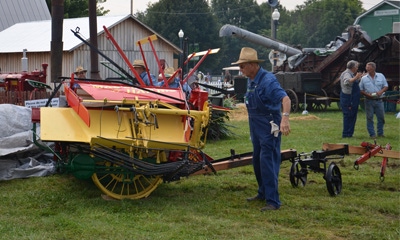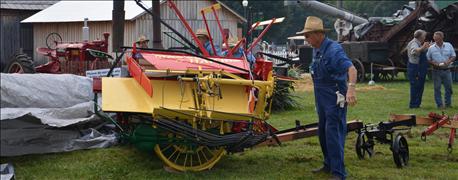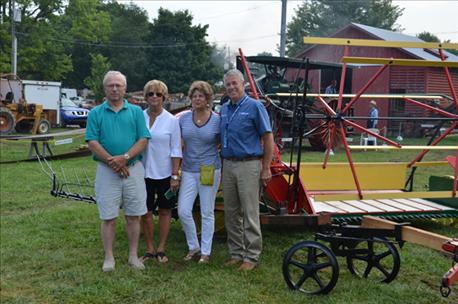
You won’t find a Massey-Harris No. 5 binder working at very many old-time threshing demonstrations. According to insiders in the antique farm machinery world, only a limited number of these units were made. You would drive hundreds of miles to find one in restored condition and in as good of shape as the one that now resides at Pioneer Village on the Indiana State Fairgrounds.
One of the highlights at Pioneer Village this year was the unveiling of the restored binder, which was gifted during the opening demonstration session at the state fair. Jim Cherry, Greenfield, his younger brother Bob, and their families first donated the binder to Purdue University, and then to Pioneer Village.

RESTORED LIKE NEW: This rare binder with a unique history is now part of the permanent display at Pioneer Village at the Indiana State Fairgrounds.
Unique tale
Antique machinery is even more interesting if there is a story behind it. There is definitely a story behind how this old binder made its way first to Greenfield and then eventually to Pioneer Village. Bob Cherry, recently retired as a government specialist for Indiana Farm Bureau Inc. and still a state representative, says he doesn’t recall much about using the binder. However, Jim, who is older, recalls the story well.
“It was 1958, and it was a wet year,” Jim says. “Everyone in our area was having trouble getting hay put up for the winter. So Dad went to an auction in Greenville, Ohio, bought it and brought it home. We actually used it to help salvage the crop."
Jim recalls pulling the binder with a Farmall tractor. When presented to Pioneer Village, it was equipped with a horse hitch, which would have been standard when the binder was sold new.

Jim Cherry and his wife, Susan, (left) and Bob Cherry and his wife, Deb, (right) donated this rare Massey-Harris binder to Pioneer Village during the 2016 Indiana State Fair.
“After that one time, we never used it again,” Jim continues. “It sat in the barn for years. When Bob and I finally decided we needed the space, we knew it had to go somewhere, and we wanted other people to be able to see it.”
Brought back to life
While the binder was still in working order, time had taken a toll on its condition. The man who brought it back to life — and to nearly factory-new condition — was Gary Napiwocki, Emmert’s Junction, Wis. He runs a small machine shop and has restored a few other binders. He was so excited to see the restored binder get a new home that he traveled from Wisconsin to attend the unveiling.
While the exact age of the machine hasn't been pinpointed, Jim Cherry nails it down to the general era, likely in the early 1900s. “It doesn’t have grease zerks,” he says. “That kind of puts it back into an older era.”
About the Author(s)
You May Also Like




